BX2174: Research & Decision Making for Business - Hahndorf Analysis
VerifiedAdded on 2022/08/24
|10
|2737
|13
Report
AI Summary
This report analyzes research and decision-making strategies for Hahndorf Village, focusing on shopper evaluation and satisfaction. It addresses the impact of e-commerce on the village's shopping experience and explores factors influencing customer satisfaction. The research employs a descriptive research design, utilizing random probability and non-probability convenience sampling methods to collect both quantitative and qualitative data through surveys and interviews. Key variables include Hahndorf shopping village, rural shopping trends, online shopping, customer buying behaviors, and the role of innovation and technology, such as Wi-Fi and website management, in attracting customers. The study also considers ethical issues, ensuring respondent anonymity and the academic purpose of the research. The ultimate goal is to provide solutions for enhancing the village's appeal and competitiveness in the face of changing consumer preferences.

Running head: RESEARCH AND DECISION MAKING FOR BUSINESS
Research and Decision making for business
Name of student
Name of University
Author note
Research and Decision making for business
Name of student
Name of University
Author note
Paraphrase This Document
Need a fresh take? Get an instant paraphrase of this document with our AI Paraphraser
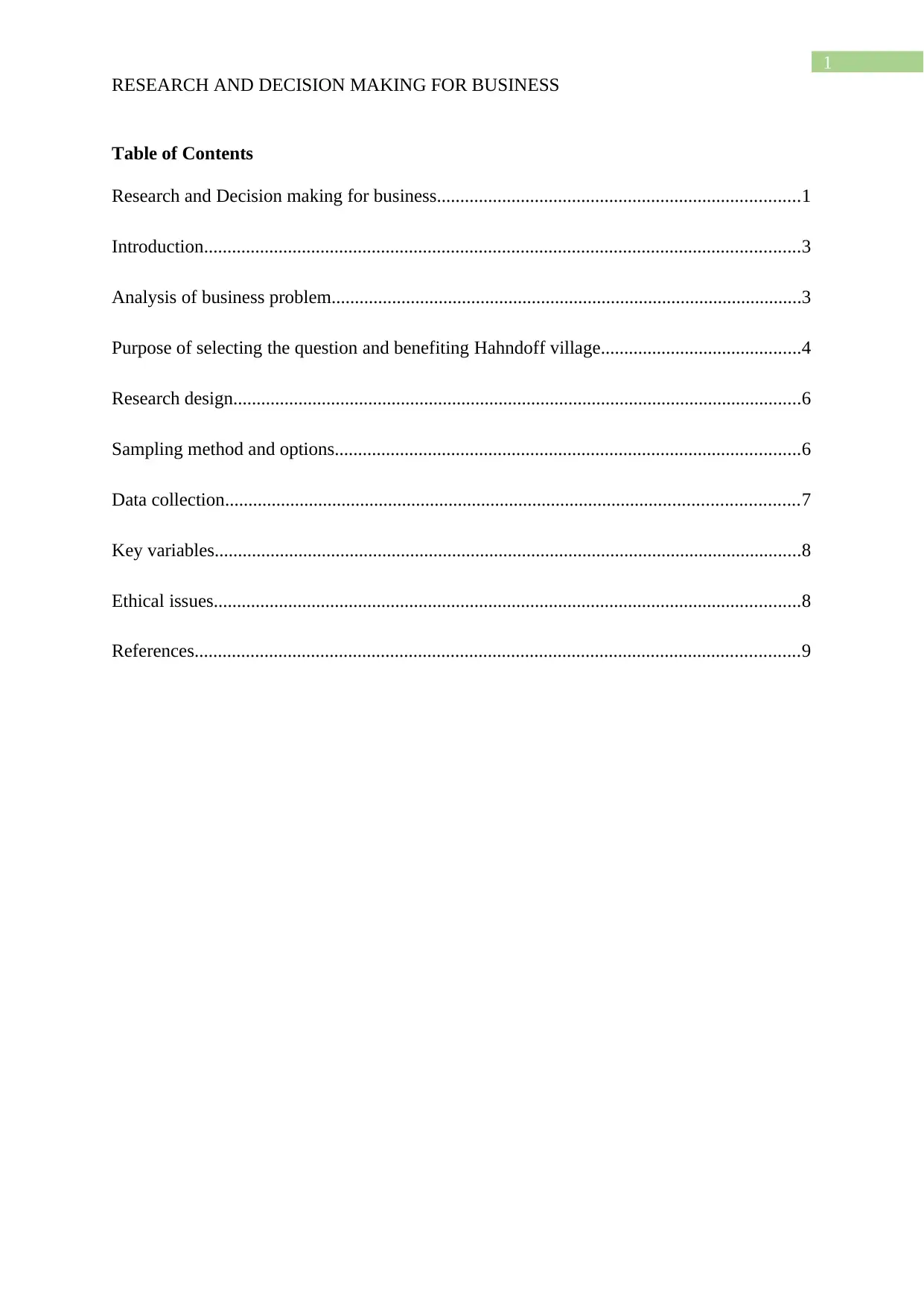
1
RESEARCH AND DECISION MAKING FOR BUSINESS
Table of Contents
Research and Decision making for business..............................................................................1
Introduction................................................................................................................................3
Analysis of business problem.....................................................................................................3
Purpose of selecting the question and benefiting Hahndoff village...........................................4
Research design..........................................................................................................................6
Sampling method and options....................................................................................................6
Data collection...........................................................................................................................7
Key variables..............................................................................................................................8
Ethical issues..............................................................................................................................8
References..................................................................................................................................9
RESEARCH AND DECISION MAKING FOR BUSINESS
Table of Contents
Research and Decision making for business..............................................................................1
Introduction................................................................................................................................3
Analysis of business problem.....................................................................................................3
Purpose of selecting the question and benefiting Hahndoff village...........................................4
Research design..........................................................................................................................6
Sampling method and options....................................................................................................6
Data collection...........................................................................................................................7
Key variables..............................................................................................................................8
Ethical issues..............................................................................................................................8
References..................................................................................................................................9
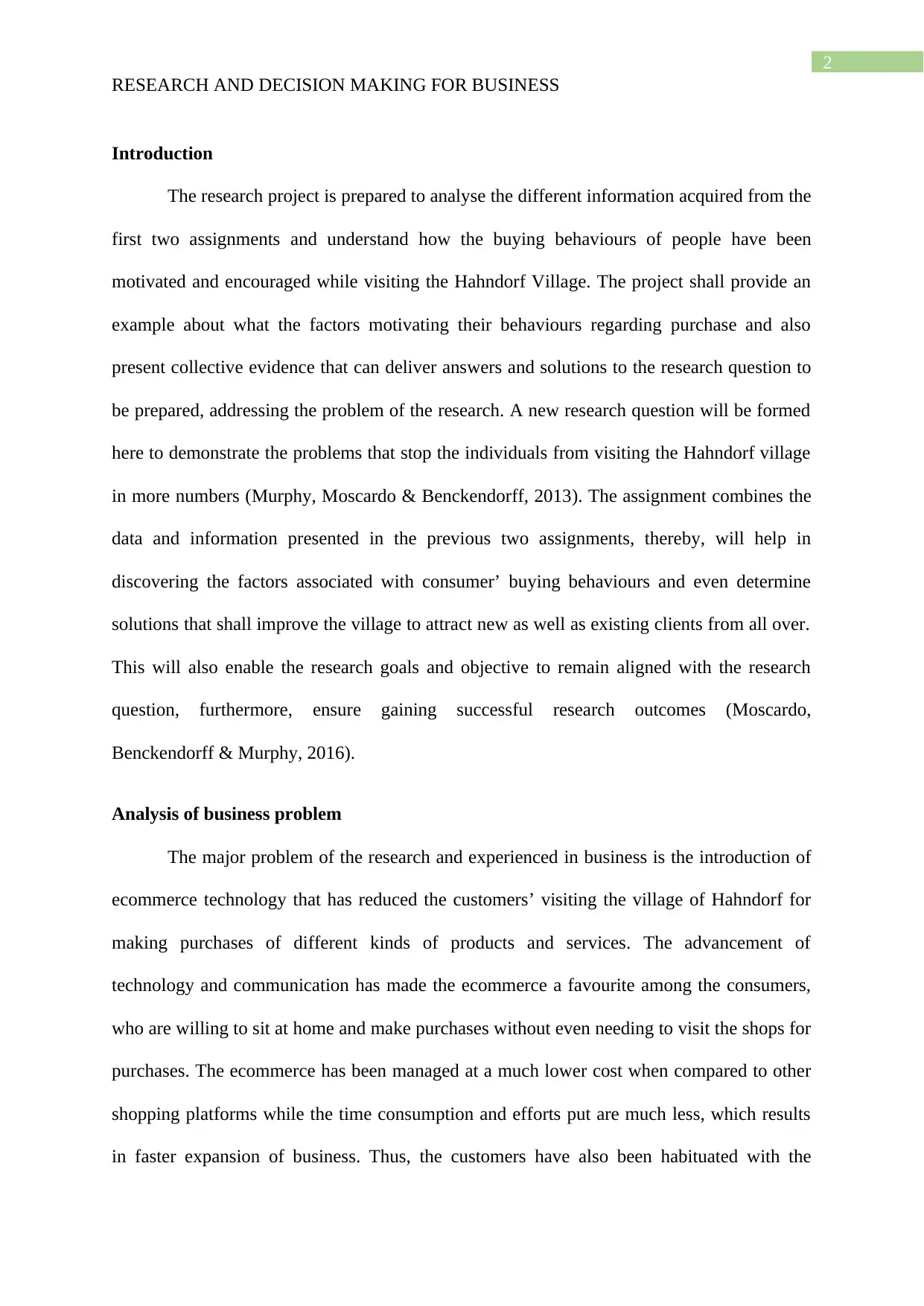
2
RESEARCH AND DECISION MAKING FOR BUSINESS
Introduction
The research project is prepared to analyse the different information acquired from the
first two assignments and understand how the buying behaviours of people have been
motivated and encouraged while visiting the Hahndorf Village. The project shall provide an
example about what the factors motivating their behaviours regarding purchase and also
present collective evidence that can deliver answers and solutions to the research question to
be prepared, addressing the problem of the research. A new research question will be formed
here to demonstrate the problems that stop the individuals from visiting the Hahndorf village
in more numbers (Murphy, Moscardo & Benckendorff, 2013). The assignment combines the
data and information presented in the previous two assignments, thereby, will help in
discovering the factors associated with consumer’ buying behaviours and even determine
solutions that shall improve the village to attract new as well as existing clients from all over.
This will also enable the research goals and objective to remain aligned with the research
question, furthermore, ensure gaining successful research outcomes (Moscardo,
Benckendorff & Murphy, 2016).
Analysis of business problem
The major problem of the research and experienced in business is the introduction of
ecommerce technology that has reduced the customers’ visiting the village of Hahndorf for
making purchases of different kinds of products and services. The advancement of
technology and communication has made the ecommerce a favourite among the consumers,
who are willing to sit at home and make purchases without even needing to visit the shops for
purchases. The ecommerce has been managed at a much lower cost when compared to other
shopping platforms while the time consumption and efforts put are much less, which results
in faster expansion of business. Thus, the customers have also been habituated with the
RESEARCH AND DECISION MAKING FOR BUSINESS
Introduction
The research project is prepared to analyse the different information acquired from the
first two assignments and understand how the buying behaviours of people have been
motivated and encouraged while visiting the Hahndorf Village. The project shall provide an
example about what the factors motivating their behaviours regarding purchase and also
present collective evidence that can deliver answers and solutions to the research question to
be prepared, addressing the problem of the research. A new research question will be formed
here to demonstrate the problems that stop the individuals from visiting the Hahndorf village
in more numbers (Murphy, Moscardo & Benckendorff, 2013). The assignment combines the
data and information presented in the previous two assignments, thereby, will help in
discovering the factors associated with consumer’ buying behaviours and even determine
solutions that shall improve the village to attract new as well as existing clients from all over.
This will also enable the research goals and objective to remain aligned with the research
question, furthermore, ensure gaining successful research outcomes (Moscardo,
Benckendorff & Murphy, 2016).
Analysis of business problem
The major problem of the research and experienced in business is the introduction of
ecommerce technology that has reduced the customers’ visiting the village of Hahndorf for
making purchases of different kinds of products and services. The advancement of
technology and communication has made the ecommerce a favourite among the consumers,
who are willing to sit at home and make purchases without even needing to visit the shops for
purchases. The ecommerce has been managed at a much lower cost when compared to other
shopping platforms while the time consumption and efforts put are much less, which results
in faster expansion of business. Thus, the customers have also been habituated with the
⊘ This is a preview!⊘
Do you want full access?
Subscribe today to unlock all pages.

Trusted by 1+ million students worldwide
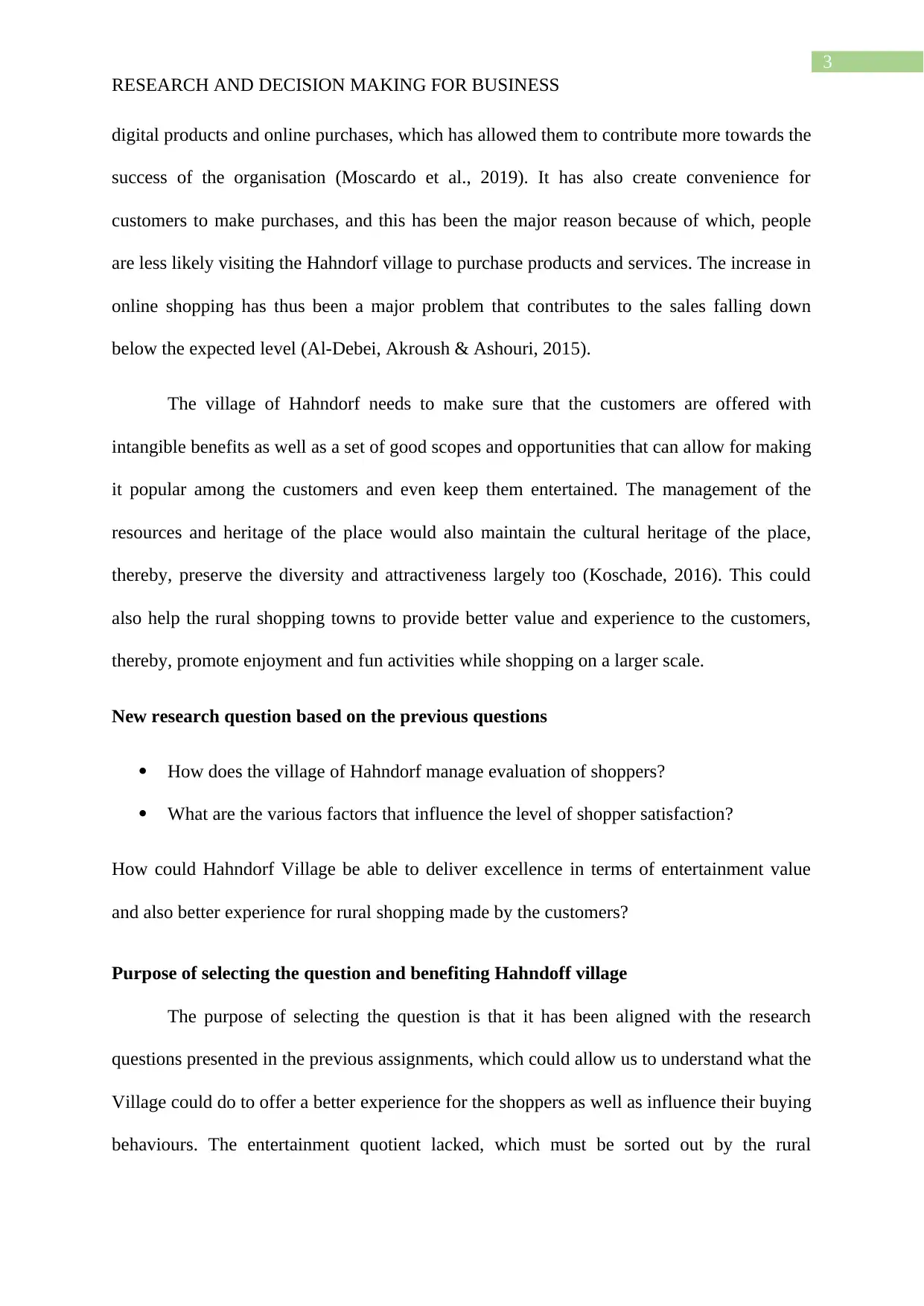
3
RESEARCH AND DECISION MAKING FOR BUSINESS
digital products and online purchases, which has allowed them to contribute more towards the
success of the organisation (Moscardo et al., 2019). It has also create convenience for
customers to make purchases, and this has been the major reason because of which, people
are less likely visiting the Hahndorf village to purchase products and services. The increase in
online shopping has thus been a major problem that contributes to the sales falling down
below the expected level (Al-Debei, Akroush & Ashouri, 2015).
The village of Hahndorf needs to make sure that the customers are offered with
intangible benefits as well as a set of good scopes and opportunities that can allow for making
it popular among the customers and even keep them entertained. The management of the
resources and heritage of the place would also maintain the cultural heritage of the place,
thereby, preserve the diversity and attractiveness largely too (Koschade, 2016). This could
also help the rural shopping towns to provide better value and experience to the customers,
thereby, promote enjoyment and fun activities while shopping on a larger scale.
New research question based on the previous questions
How does the village of Hahndorf manage evaluation of shoppers?
What are the various factors that influence the level of shopper satisfaction?
How could Hahndorf Village be able to deliver excellence in terms of entertainment value
and also better experience for rural shopping made by the customers?
Purpose of selecting the question and benefiting Hahndoff village
The purpose of selecting the question is that it has been aligned with the research
questions presented in the previous assignments, which could allow us to understand what the
Village could do to offer a better experience for the shoppers as well as influence their buying
behaviours. The entertainment quotient lacked, which must be sorted out by the rural
RESEARCH AND DECISION MAKING FOR BUSINESS
digital products and online purchases, which has allowed them to contribute more towards the
success of the organisation (Moscardo et al., 2019). It has also create convenience for
customers to make purchases, and this has been the major reason because of which, people
are less likely visiting the Hahndorf village to purchase products and services. The increase in
online shopping has thus been a major problem that contributes to the sales falling down
below the expected level (Al-Debei, Akroush & Ashouri, 2015).
The village of Hahndorf needs to make sure that the customers are offered with
intangible benefits as well as a set of good scopes and opportunities that can allow for making
it popular among the customers and even keep them entertained. The management of the
resources and heritage of the place would also maintain the cultural heritage of the place,
thereby, preserve the diversity and attractiveness largely too (Koschade, 2016). This could
also help the rural shopping towns to provide better value and experience to the customers,
thereby, promote enjoyment and fun activities while shopping on a larger scale.
New research question based on the previous questions
How does the village of Hahndorf manage evaluation of shoppers?
What are the various factors that influence the level of shopper satisfaction?
How could Hahndorf Village be able to deliver excellence in terms of entertainment value
and also better experience for rural shopping made by the customers?
Purpose of selecting the question and benefiting Hahndoff village
The purpose of selecting the question is that it has been aligned with the research
questions presented in the previous assignments, which could allow us to understand what the
Village could do to offer a better experience for the shoppers as well as influence their buying
behaviours. The entertainment quotient lacked, which must be sorted out by the rural
Paraphrase This Document
Need a fresh take? Get an instant paraphrase of this document with our AI Paraphraser
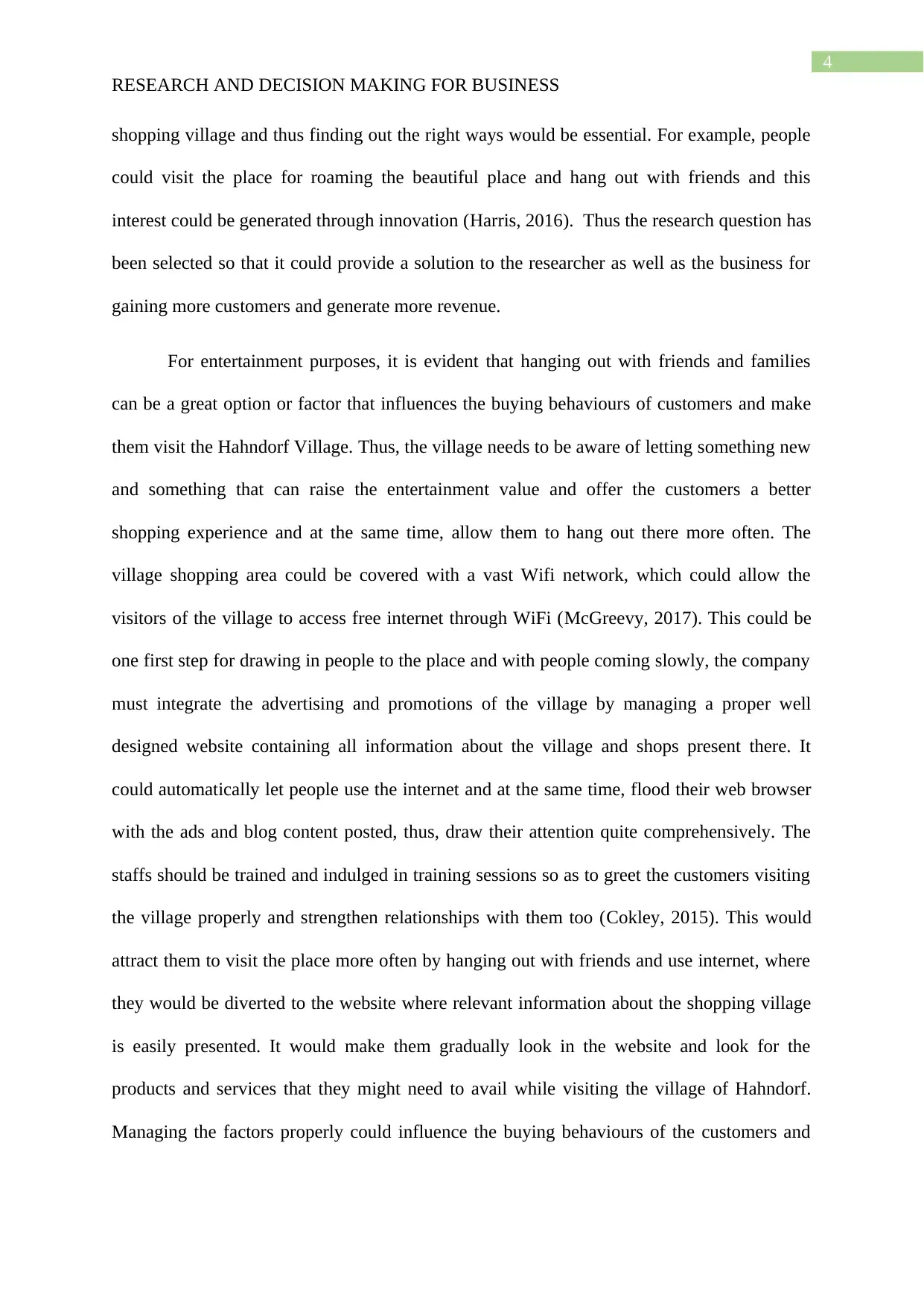
4
RESEARCH AND DECISION MAKING FOR BUSINESS
shopping village and thus finding out the right ways would be essential. For example, people
could visit the place for roaming the beautiful place and hang out with friends and this
interest could be generated through innovation (Harris, 2016). Thus the research question has
been selected so that it could provide a solution to the researcher as well as the business for
gaining more customers and generate more revenue.
For entertainment purposes, it is evident that hanging out with friends and families
can be a great option or factor that influences the buying behaviours of customers and make
them visit the Hahndorf Village. Thus, the village needs to be aware of letting something new
and something that can raise the entertainment value and offer the customers a better
shopping experience and at the same time, allow them to hang out there more often. The
village shopping area could be covered with a vast Wifi network, which could allow the
visitors of the village to access free internet through WiFi (McGreevy, 2017). This could be
one first step for drawing in people to the place and with people coming slowly, the company
must integrate the advertising and promotions of the village by managing a proper well
designed website containing all information about the village and shops present there. It
could automatically let people use the internet and at the same time, flood their web browser
with the ads and blog content posted, thus, draw their attention quite comprehensively. The
staffs should be trained and indulged in training sessions so as to greet the customers visiting
the village properly and strengthen relationships with them too (Cokley, 2015). This would
attract them to visit the place more often by hanging out with friends and use internet, where
they would be diverted to the website where relevant information about the shopping village
is easily presented. It would make them gradually look in the website and look for the
products and services that they might need to avail while visiting the village of Hahndorf.
Managing the factors properly could influence the buying behaviours of the customers and
RESEARCH AND DECISION MAKING FOR BUSINESS
shopping village and thus finding out the right ways would be essential. For example, people
could visit the place for roaming the beautiful place and hang out with friends and this
interest could be generated through innovation (Harris, 2016). Thus the research question has
been selected so that it could provide a solution to the researcher as well as the business for
gaining more customers and generate more revenue.
For entertainment purposes, it is evident that hanging out with friends and families
can be a great option or factor that influences the buying behaviours of customers and make
them visit the Hahndorf Village. Thus, the village needs to be aware of letting something new
and something that can raise the entertainment value and offer the customers a better
shopping experience and at the same time, allow them to hang out there more often. The
village shopping area could be covered with a vast Wifi network, which could allow the
visitors of the village to access free internet through WiFi (McGreevy, 2017). This could be
one first step for drawing in people to the place and with people coming slowly, the company
must integrate the advertising and promotions of the village by managing a proper well
designed website containing all information about the village and shops present there. It
could automatically let people use the internet and at the same time, flood their web browser
with the ads and blog content posted, thus, draw their attention quite comprehensively. The
staffs should be trained and indulged in training sessions so as to greet the customers visiting
the village properly and strengthen relationships with them too (Cokley, 2015). This would
attract them to visit the place more often by hanging out with friends and use internet, where
they would be diverted to the website where relevant information about the shopping village
is easily presented. It would make them gradually look in the website and look for the
products and services that they might need to avail while visiting the village of Hahndorf.
Managing the factors properly could influence the buying behaviours of the customers and
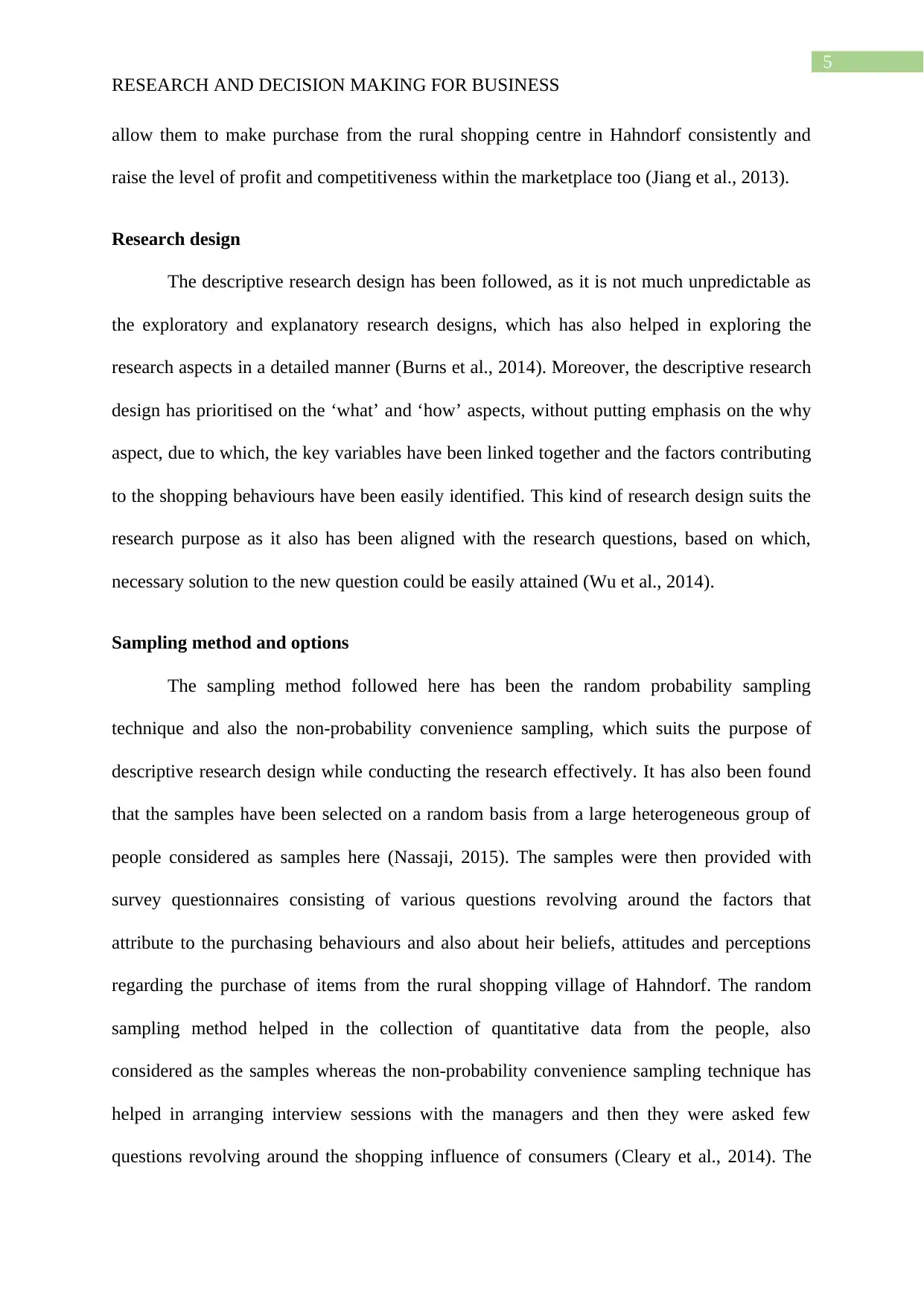
5
RESEARCH AND DECISION MAKING FOR BUSINESS
allow them to make purchase from the rural shopping centre in Hahndorf consistently and
raise the level of profit and competitiveness within the marketplace too (Jiang et al., 2013).
Research design
The descriptive research design has been followed, as it is not much unpredictable as
the exploratory and explanatory research designs, which has also helped in exploring the
research aspects in a detailed manner (Burns et al., 2014). Moreover, the descriptive research
design has prioritised on the ‘what’ and ‘how’ aspects, without putting emphasis on the why
aspect, due to which, the key variables have been linked together and the factors contributing
to the shopping behaviours have been easily identified. This kind of research design suits the
research purpose as it also has been aligned with the research questions, based on which,
necessary solution to the new question could be easily attained (Wu et al., 2014).
Sampling method and options
The sampling method followed here has been the random probability sampling
technique and also the non-probability convenience sampling, which suits the purpose of
descriptive research design while conducting the research effectively. It has also been found
that the samples have been selected on a random basis from a large heterogeneous group of
people considered as samples here (Nassaji, 2015). The samples were then provided with
survey questionnaires consisting of various questions revolving around the factors that
attribute to the purchasing behaviours and also about heir beliefs, attitudes and perceptions
regarding the purchase of items from the rural shopping village of Hahndorf. The random
sampling method helped in the collection of quantitative data from the people, also
considered as the samples whereas the non-probability convenience sampling technique has
helped in arranging interview sessions with the managers and then they were asked few
questions revolving around the shopping influence of consumers (Cleary et al., 2014). The
RESEARCH AND DECISION MAKING FOR BUSINESS
allow them to make purchase from the rural shopping centre in Hahndorf consistently and
raise the level of profit and competitiveness within the marketplace too (Jiang et al., 2013).
Research design
The descriptive research design has been followed, as it is not much unpredictable as
the exploratory and explanatory research designs, which has also helped in exploring the
research aspects in a detailed manner (Burns et al., 2014). Moreover, the descriptive research
design has prioritised on the ‘what’ and ‘how’ aspects, without putting emphasis on the why
aspect, due to which, the key variables have been linked together and the factors contributing
to the shopping behaviours have been easily identified. This kind of research design suits the
research purpose as it also has been aligned with the research questions, based on which,
necessary solution to the new question could be easily attained (Wu et al., 2014).
Sampling method and options
The sampling method followed here has been the random probability sampling
technique and also the non-probability convenience sampling, which suits the purpose of
descriptive research design while conducting the research effectively. It has also been found
that the samples have been selected on a random basis from a large heterogeneous group of
people considered as samples here (Nassaji, 2015). The samples were then provided with
survey questionnaires consisting of various questions revolving around the factors that
attribute to the purchasing behaviours and also about heir beliefs, attitudes and perceptions
regarding the purchase of items from the rural shopping village of Hahndorf. The random
sampling method helped in the collection of quantitative data from the people, also
considered as the samples whereas the non-probability convenience sampling technique has
helped in arranging interview sessions with the managers and then they were asked few
questions revolving around the shopping influence of consumers (Cleary et al., 2014). The
⊘ This is a preview!⊘
Do you want full access?
Subscribe today to unlock all pages.

Trusted by 1+ million students worldwide
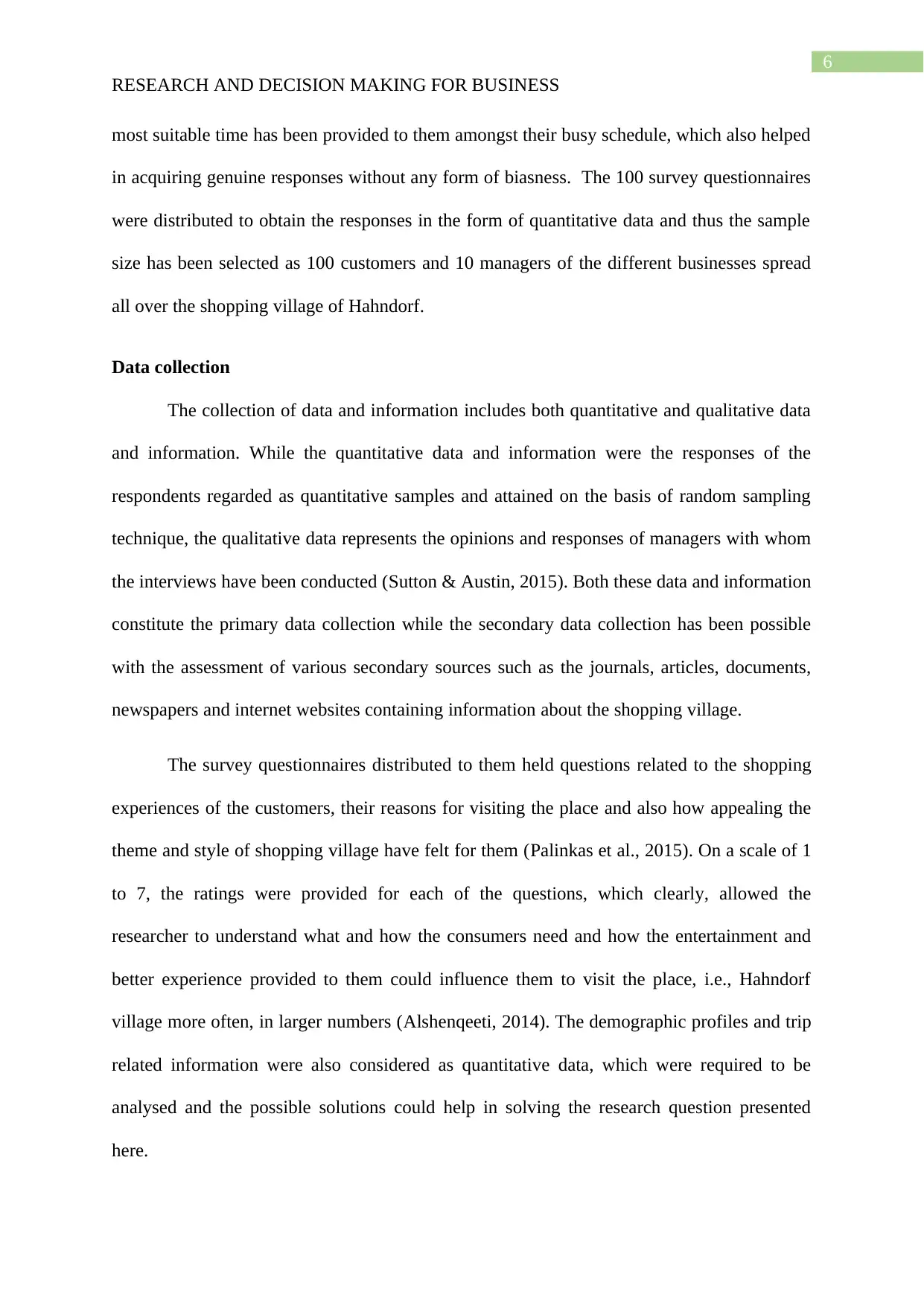
6
RESEARCH AND DECISION MAKING FOR BUSINESS
most suitable time has been provided to them amongst their busy schedule, which also helped
in acquiring genuine responses without any form of biasness. The 100 survey questionnaires
were distributed to obtain the responses in the form of quantitative data and thus the sample
size has been selected as 100 customers and 10 managers of the different businesses spread
all over the shopping village of Hahndorf.
Data collection
The collection of data and information includes both quantitative and qualitative data
and information. While the quantitative data and information were the responses of the
respondents regarded as quantitative samples and attained on the basis of random sampling
technique, the qualitative data represents the opinions and responses of managers with whom
the interviews have been conducted (Sutton & Austin, 2015). Both these data and information
constitute the primary data collection while the secondary data collection has been possible
with the assessment of various secondary sources such as the journals, articles, documents,
newspapers and internet websites containing information about the shopping village.
The survey questionnaires distributed to them held questions related to the shopping
experiences of the customers, their reasons for visiting the place and also how appealing the
theme and style of shopping village have felt for them (Palinkas et al., 2015). On a scale of 1
to 7, the ratings were provided for each of the questions, which clearly, allowed the
researcher to understand what and how the consumers need and how the entertainment and
better experience provided to them could influence them to visit the place, i.e., Hahndorf
village more often, in larger numbers (Alshenqeeti, 2014). The demographic profiles and trip
related information were also considered as quantitative data, which were required to be
analysed and the possible solutions could help in solving the research question presented
here.
RESEARCH AND DECISION MAKING FOR BUSINESS
most suitable time has been provided to them amongst their busy schedule, which also helped
in acquiring genuine responses without any form of biasness. The 100 survey questionnaires
were distributed to obtain the responses in the form of quantitative data and thus the sample
size has been selected as 100 customers and 10 managers of the different businesses spread
all over the shopping village of Hahndorf.
Data collection
The collection of data and information includes both quantitative and qualitative data
and information. While the quantitative data and information were the responses of the
respondents regarded as quantitative samples and attained on the basis of random sampling
technique, the qualitative data represents the opinions and responses of managers with whom
the interviews have been conducted (Sutton & Austin, 2015). Both these data and information
constitute the primary data collection while the secondary data collection has been possible
with the assessment of various secondary sources such as the journals, articles, documents,
newspapers and internet websites containing information about the shopping village.
The survey questionnaires distributed to them held questions related to the shopping
experiences of the customers, their reasons for visiting the place and also how appealing the
theme and style of shopping village have felt for them (Palinkas et al., 2015). On a scale of 1
to 7, the ratings were provided for each of the questions, which clearly, allowed the
researcher to understand what and how the consumers need and how the entertainment and
better experience provided to them could influence them to visit the place, i.e., Hahndorf
village more often, in larger numbers (Alshenqeeti, 2014). The demographic profiles and trip
related information were also considered as quantitative data, which were required to be
analysed and the possible solutions could help in solving the research question presented
here.
Paraphrase This Document
Need a fresh take? Get an instant paraphrase of this document with our AI Paraphraser
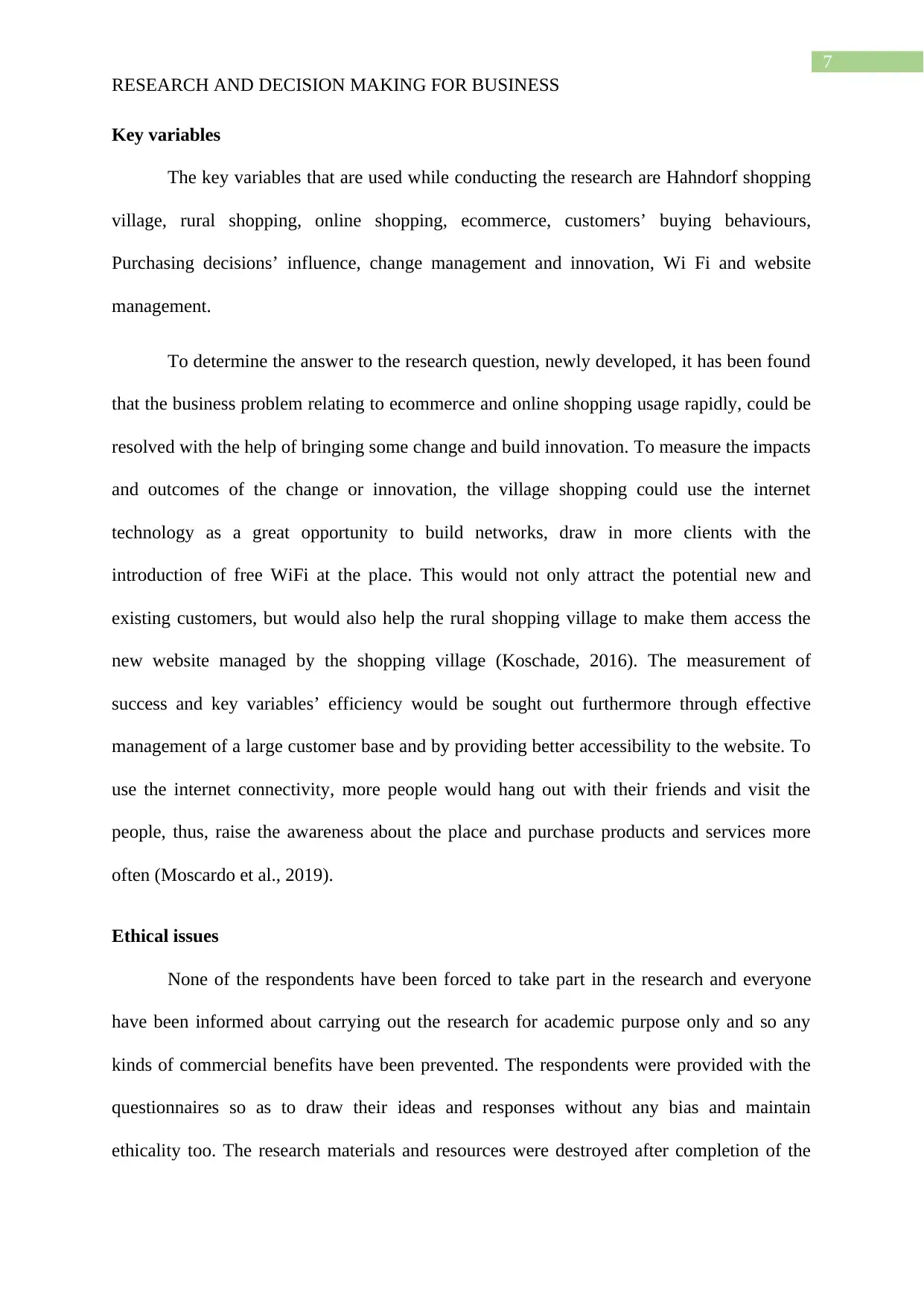
7
RESEARCH AND DECISION MAKING FOR BUSINESS
Key variables
The key variables that are used while conducting the research are Hahndorf shopping
village, rural shopping, online shopping, ecommerce, customers’ buying behaviours,
Purchasing decisions’ influence, change management and innovation, Wi Fi and website
management.
To determine the answer to the research question, newly developed, it has been found
that the business problem relating to ecommerce and online shopping usage rapidly, could be
resolved with the help of bringing some change and build innovation. To measure the impacts
and outcomes of the change or innovation, the village shopping could use the internet
technology as a great opportunity to build networks, draw in more clients with the
introduction of free WiFi at the place. This would not only attract the potential new and
existing customers, but would also help the rural shopping village to make them access the
new website managed by the shopping village (Koschade, 2016). The measurement of
success and key variables’ efficiency would be sought out furthermore through effective
management of a large customer base and by providing better accessibility to the website. To
use the internet connectivity, more people would hang out with their friends and visit the
people, thus, raise the awareness about the place and purchase products and services more
often (Moscardo et al., 2019).
Ethical issues
None of the respondents have been forced to take part in the research and everyone
have been informed about carrying out the research for academic purpose only and so any
kinds of commercial benefits have been prevented. The respondents were provided with the
questionnaires so as to draw their ideas and responses without any bias and maintain
ethicality too. The research materials and resources were destroyed after completion of the
RESEARCH AND DECISION MAKING FOR BUSINESS
Key variables
The key variables that are used while conducting the research are Hahndorf shopping
village, rural shopping, online shopping, ecommerce, customers’ buying behaviours,
Purchasing decisions’ influence, change management and innovation, Wi Fi and website
management.
To determine the answer to the research question, newly developed, it has been found
that the business problem relating to ecommerce and online shopping usage rapidly, could be
resolved with the help of bringing some change and build innovation. To measure the impacts
and outcomes of the change or innovation, the village shopping could use the internet
technology as a great opportunity to build networks, draw in more clients with the
introduction of free WiFi at the place. This would not only attract the potential new and
existing customers, but would also help the rural shopping village to make them access the
new website managed by the shopping village (Koschade, 2016). The measurement of
success and key variables’ efficiency would be sought out furthermore through effective
management of a large customer base and by providing better accessibility to the website. To
use the internet connectivity, more people would hang out with their friends and visit the
people, thus, raise the awareness about the place and purchase products and services more
often (Moscardo et al., 2019).
Ethical issues
None of the respondents have been forced to take part in the research and everyone
have been informed about carrying out the research for academic purpose only and so any
kinds of commercial benefits have been prevented. The respondents were provided with the
questionnaires so as to draw their ideas and responses without any bias and maintain
ethicality too. The research materials and resources were destroyed after completion of the
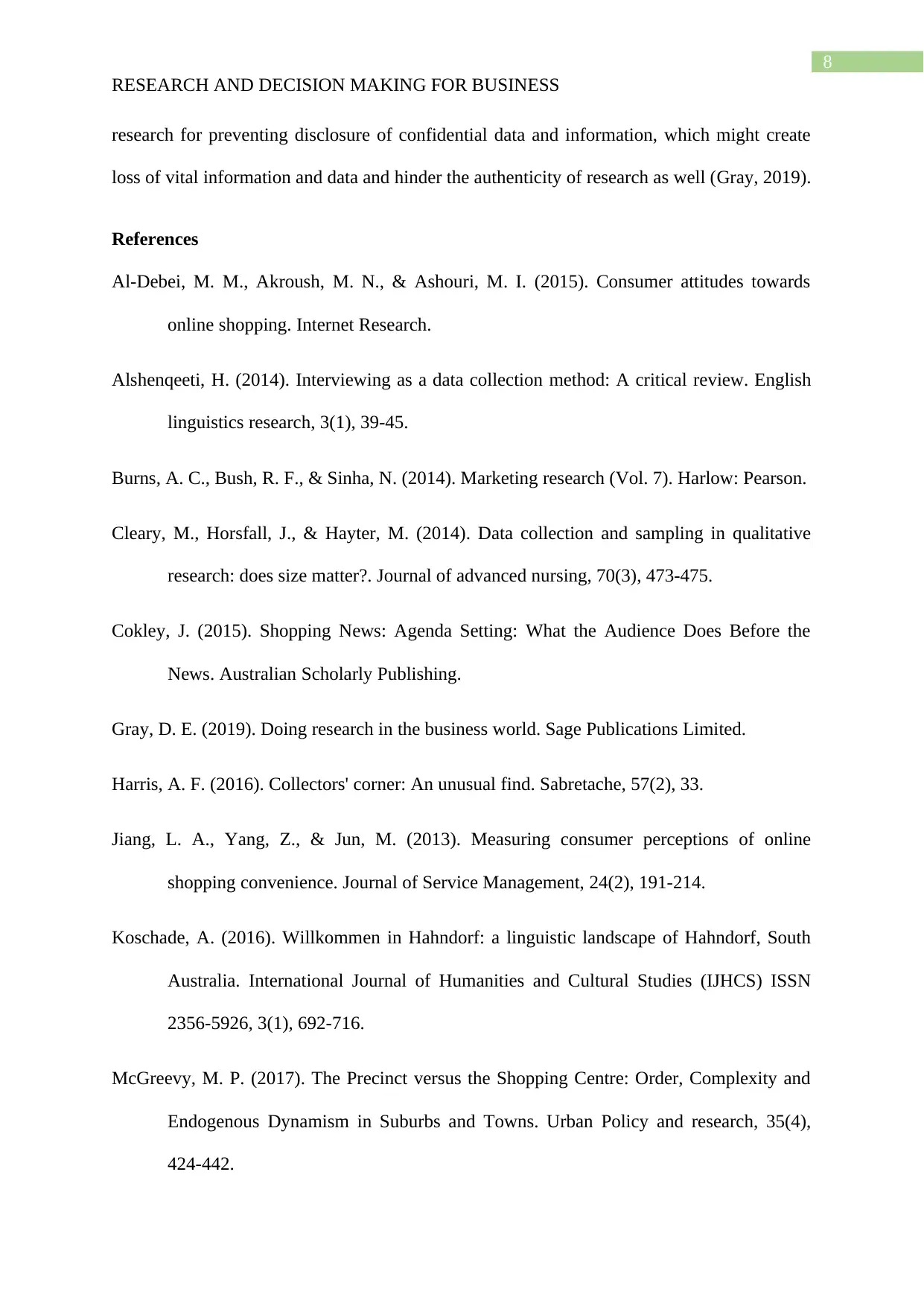
8
RESEARCH AND DECISION MAKING FOR BUSINESS
research for preventing disclosure of confidential data and information, which might create
loss of vital information and data and hinder the authenticity of research as well (Gray, 2019).
References
Al-Debei, M. M., Akroush, M. N., & Ashouri, M. I. (2015). Consumer attitudes towards
online shopping. Internet Research.
Alshenqeeti, H. (2014). Interviewing as a data collection method: A critical review. English
linguistics research, 3(1), 39-45.
Burns, A. C., Bush, R. F., & Sinha, N. (2014). Marketing research (Vol. 7). Harlow: Pearson.
Cleary, M., Horsfall, J., & Hayter, M. (2014). Data collection and sampling in qualitative
research: does size matter?. Journal of advanced nursing, 70(3), 473-475.
Cokley, J. (2015). Shopping News: Agenda Setting: What the Audience Does Before the
News. Australian Scholarly Publishing.
Gray, D. E. (2019). Doing research in the business world. Sage Publications Limited.
Harris, A. F. (2016). Collectors' corner: An unusual find. Sabretache, 57(2), 33.
Jiang, L. A., Yang, Z., & Jun, M. (2013). Measuring consumer perceptions of online
shopping convenience. Journal of Service Management, 24(2), 191-214.
Koschade, A. (2016). Willkommen in Hahndorf: a linguistic landscape of Hahndorf, South
Australia. International Journal of Humanities and Cultural Studies (IJHCS) ISSN
2356-5926, 3(1), 692-716.
McGreevy, M. P. (2017). The Precinct versus the Shopping Centre: Order, Complexity and
Endogenous Dynamism in Suburbs and Towns. Urban Policy and research, 35(4),
424-442.
RESEARCH AND DECISION MAKING FOR BUSINESS
research for preventing disclosure of confidential data and information, which might create
loss of vital information and data and hinder the authenticity of research as well (Gray, 2019).
References
Al-Debei, M. M., Akroush, M. N., & Ashouri, M. I. (2015). Consumer attitudes towards
online shopping. Internet Research.
Alshenqeeti, H. (2014). Interviewing as a data collection method: A critical review. English
linguistics research, 3(1), 39-45.
Burns, A. C., Bush, R. F., & Sinha, N. (2014). Marketing research (Vol. 7). Harlow: Pearson.
Cleary, M., Horsfall, J., & Hayter, M. (2014). Data collection and sampling in qualitative
research: does size matter?. Journal of advanced nursing, 70(3), 473-475.
Cokley, J. (2015). Shopping News: Agenda Setting: What the Audience Does Before the
News. Australian Scholarly Publishing.
Gray, D. E. (2019). Doing research in the business world. Sage Publications Limited.
Harris, A. F. (2016). Collectors' corner: An unusual find. Sabretache, 57(2), 33.
Jiang, L. A., Yang, Z., & Jun, M. (2013). Measuring consumer perceptions of online
shopping convenience. Journal of Service Management, 24(2), 191-214.
Koschade, A. (2016). Willkommen in Hahndorf: a linguistic landscape of Hahndorf, South
Australia. International Journal of Humanities and Cultural Studies (IJHCS) ISSN
2356-5926, 3(1), 692-716.
McGreevy, M. P. (2017). The Precinct versus the Shopping Centre: Order, Complexity and
Endogenous Dynamism in Suburbs and Towns. Urban Policy and research, 35(4),
424-442.
⊘ This is a preview!⊘
Do you want full access?
Subscribe today to unlock all pages.

Trusted by 1+ million students worldwide
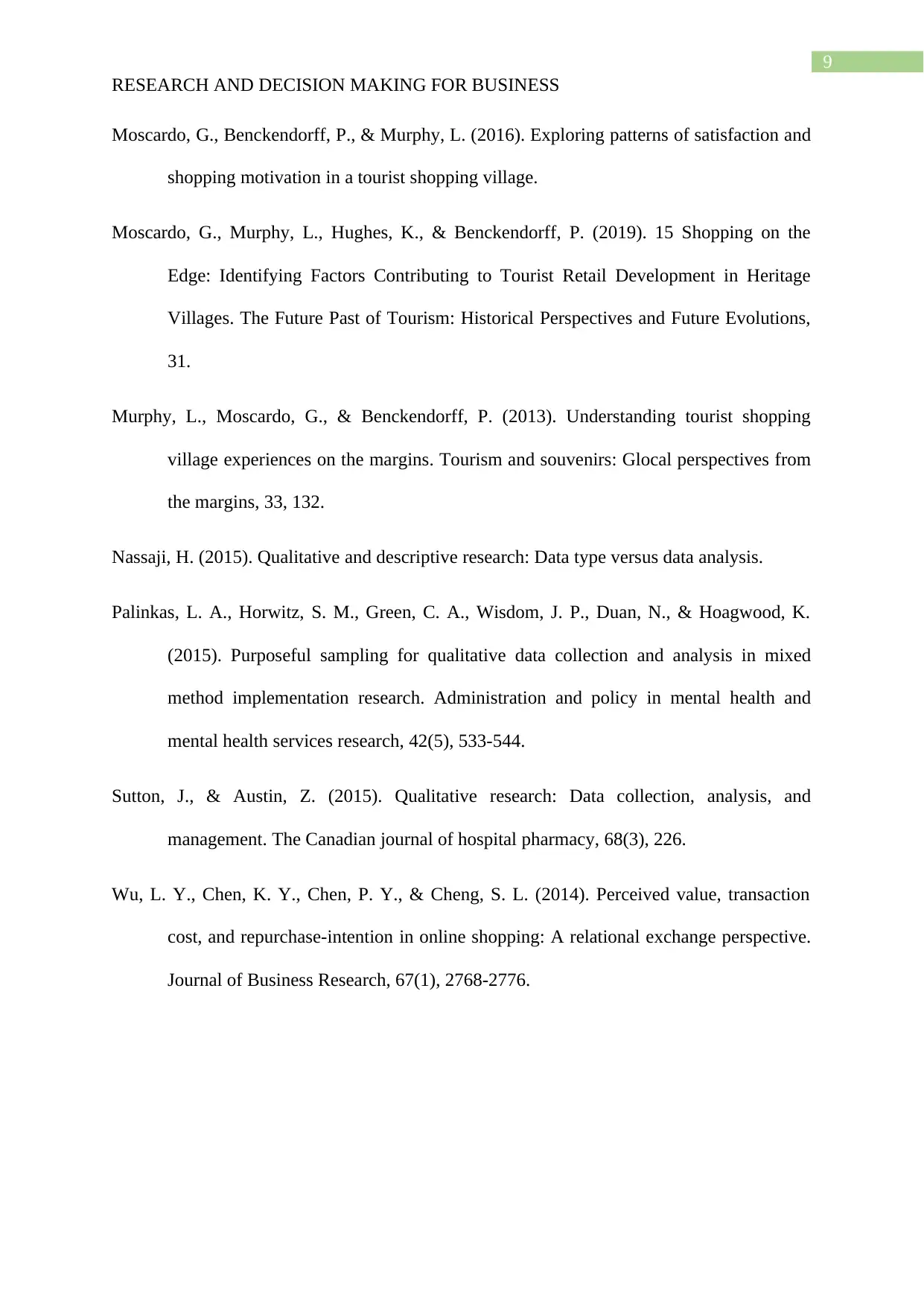
9
RESEARCH AND DECISION MAKING FOR BUSINESS
Moscardo, G., Benckendorff, P., & Murphy, L. (2016). Exploring patterns of satisfaction and
shopping motivation in a tourist shopping village.
Moscardo, G., Murphy, L., Hughes, K., & Benckendorff, P. (2019). 15 Shopping on the
Edge: Identifying Factors Contributing to Tourist Retail Development in Heritage
Villages. The Future Past of Tourism: Historical Perspectives and Future Evolutions,
31.
Murphy, L., Moscardo, G., & Benckendorff, P. (2013). Understanding tourist shopping
village experiences on the margins. Tourism and souvenirs: Glocal perspectives from
the margins, 33, 132.
Nassaji, H. (2015). Qualitative and descriptive research: Data type versus data analysis.
Palinkas, L. A., Horwitz, S. M., Green, C. A., Wisdom, J. P., Duan, N., & Hoagwood, K.
(2015). Purposeful sampling for qualitative data collection and analysis in mixed
method implementation research. Administration and policy in mental health and
mental health services research, 42(5), 533-544.
Sutton, J., & Austin, Z. (2015). Qualitative research: Data collection, analysis, and
management. The Canadian journal of hospital pharmacy, 68(3), 226.
Wu, L. Y., Chen, K. Y., Chen, P. Y., & Cheng, S. L. (2014). Perceived value, transaction
cost, and repurchase-intention in online shopping: A relational exchange perspective.
Journal of Business Research, 67(1), 2768-2776.
RESEARCH AND DECISION MAKING FOR BUSINESS
Moscardo, G., Benckendorff, P., & Murphy, L. (2016). Exploring patterns of satisfaction and
shopping motivation in a tourist shopping village.
Moscardo, G., Murphy, L., Hughes, K., & Benckendorff, P. (2019). 15 Shopping on the
Edge: Identifying Factors Contributing to Tourist Retail Development in Heritage
Villages. The Future Past of Tourism: Historical Perspectives and Future Evolutions,
31.
Murphy, L., Moscardo, G., & Benckendorff, P. (2013). Understanding tourist shopping
village experiences on the margins. Tourism and souvenirs: Glocal perspectives from
the margins, 33, 132.
Nassaji, H. (2015). Qualitative and descriptive research: Data type versus data analysis.
Palinkas, L. A., Horwitz, S. M., Green, C. A., Wisdom, J. P., Duan, N., & Hoagwood, K.
(2015). Purposeful sampling for qualitative data collection and analysis in mixed
method implementation research. Administration and policy in mental health and
mental health services research, 42(5), 533-544.
Sutton, J., & Austin, Z. (2015). Qualitative research: Data collection, analysis, and
management. The Canadian journal of hospital pharmacy, 68(3), 226.
Wu, L. Y., Chen, K. Y., Chen, P. Y., & Cheng, S. L. (2014). Perceived value, transaction
cost, and repurchase-intention in online shopping: A relational exchange perspective.
Journal of Business Research, 67(1), 2768-2776.
1 out of 10
Related Documents
Your All-in-One AI-Powered Toolkit for Academic Success.
+13062052269
info@desklib.com
Available 24*7 on WhatsApp / Email
![[object Object]](/_next/static/media/star-bottom.7253800d.svg)
Unlock your academic potential
Copyright © 2020–2025 A2Z Services. All Rights Reserved. Developed and managed by ZUCOL.





